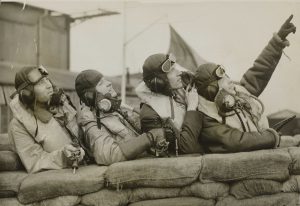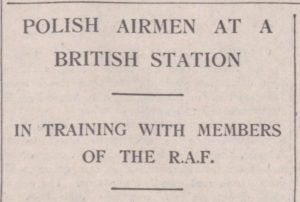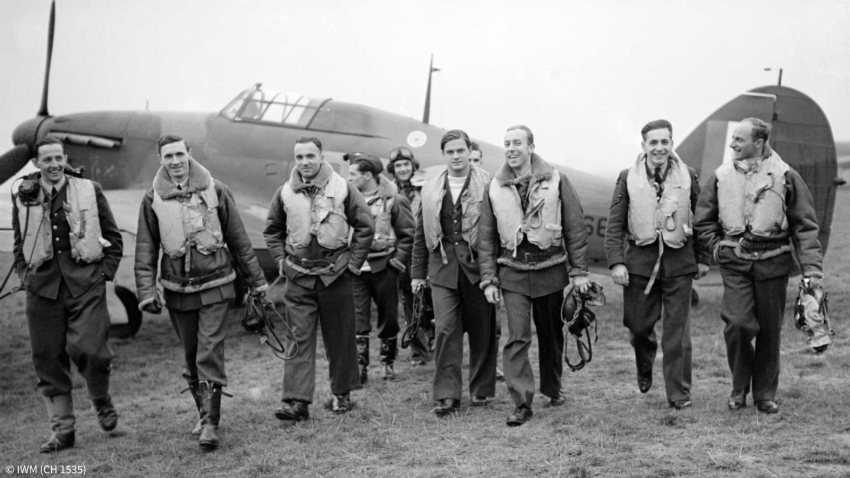In the first instalment of our Battle of Britain 2023 blog, we spotlight the Polish No. 303 Squadron of the Royal Air Force. After discovering a striking photograph of squadron members (above), we decided to delve into the records and explore the names behind the faces. But first – what was No. 303 Squadron, and what kind of records are available for researching Polish airmen and other Battle of Britain ancestors?
Volunteers from all over the world
During the Second World War, the RAF could count a number of foreign nationals amongst its ranks. Pilots came from all over the world, including the former British Empire. Another group of recruits bolstered the RAF during the war; exiled airmen who had escaped countries under Nazi occupation before and during WWII. They came from nations such as France, Belgium, the Netherlands, Norway, Greece, Czechoslovakia, Yugoslavia and Poland and formed their own squadrons within the RAF throughout the war. Many would play an important role during the Battle of Britain.
The Battle of Britain
By June 1940, large swathes of Europe had fallen under Nazi Germany’s control, including France. It was feared that Britain was next. In preparation for an invasion, Germany attempted to gain air superiority over the RAF. Lasting from 10 July to 31 October 1940, the Battle of Britain was the first major military campaign to be fought in the air, primarily unfolding over Southern England.

It was a hard-fought battle, but the RAF did not allow the Luftwaffe to gain air superiority and pave the way for an invasion of Britain. Those on the ground and in the air made huge sacrifices and contributions to this impressive defensive victory.
During the Battle of Britain, one-fifth of Fighter Command’s aircrew came from overseas. The largest contingent hailed from Poland, with 145 Poles flying during the battle. They would make a vital contribution during the Battle of Britain, particularly members of the Polish Number 303 Squadron of the RAF.
No. 303 Squadron RAF – ‘Tadeusz Kościuszko Warsaw Fighter Squadron’
303 Squadron formed on 2 August 1940 and began training at RAF Northolt in West London. By the end of the month, it was ready to take on the Luftwaffe during the Battle of Britain. Many of its members had pre-war military experience and had seen action during the fighting in Poland between September and October 1939. When their homeland was overrun, some escaped to France and took up arms once more against Nazi Germany. When France fell in June 1940, those who could, fled to Britain, some via North Africa and Gibraltar.
Despite joining the Battle of Britain in late August, the pilots of 303 squadron proved to be formidable in action, destroying 126 enemy planes, the most of any Fighter Command squadron during the battle.
‘Had it not been for the magnificent material contributed by the Polish squadrons and their unsurpassed gallantry,’ wrote Air Chief Marshal Sir Hugh Dowding, ‘I hesitate to say that the outcome of the Battle of Britain would have been the same.’
Names behind the photograph
The image at the top of this article is of members of 303 Squadron, available in Ancestry’s UK, Wartime Records and Material, 1914-1918, 1939-1945 collection, courtesy of the Imperial War Museum (IWM). Walking towards the camera, many of the pilots are smiling, looking relaxed and nonchalant. A Hawker Hurricane fighter aircraft can be seen in the background. This was the main aircraft used by the squadron during the battle, but they later converted to Spitfires. The photo was taken on 24 October 1940 at RAF Leconfield in Yorkshire. The squadron moved here in early October for respite.
The full image caption, available on the IWM website, names each pilot in the photo. This was an exciting find, as not all military photos, whether in personal or public collections, are named. Clues like these are invaluable when researching military ancestors, not least when researching Polish airmen, and allowed us to turn our attention to the records to learn more about their wartime stores.
Researching Polish airmen – the records
An airman’s service record is the ultimate source for researching their wartime service, detailing when they enlisted, the squadrons and units they served with and other pertinent military and genealogical information. WWII service records, including those of Polish personnel, are held by the Ministry of Defence (MOD). You can apply for WWII service records via the MOD website. The Polish Exiles of WWII website provides useful tips on applying for Polish service records through the MOD and where to apply for records of personnel who served with Polish forces before and early on in WWII.
One of the most valuable sources for researching the Polish pilots in the above photo was the World War II Index to Allied Airmen Roll of Honour, 1939-1945, available on Forces War Records. This collection of comprehensive records contains a Roll of Honour for British and Allied air service members who lost their lives in service during WWII. Basic military details are provided in the collection, in addition to the aircraft the person was flying or flying in and the circumstances surrounding their death. Clues found in this collection can help you target other WWII records.
Many RAF pilots and aircrew became prisoners of war during WWII, often after being shot down over enemy-occupied territory. Prisoner of war records are helpful for establishing where our ancestors were held during the war, allowing us to paint a fuller picture of their wartime service. The Allied Prisoners of War, 1939-1945 collection, available on Forces War Records, is a great resource for researching RAF ancestors who became prisoners of war in WWII.

The Royal Air Force Operations Record Books (ORB), available via Ancestry, were also of great assistance during our research. The ORBs provide a day-to-day account of a squadron’s activities, detailing missions and sorties, along with the names of pilots or aircrew and their aircraft numbers. It allows us to gain a greater understanding of our ancestors’ experiences during the war.
Newspapers are a fantastic source for researching our military ancestors, and in this instance, when researching Polish airmen. Available from Newspapers.com, some of the pilots named in the photo were detailed in newspapers for their heroics and bravery in action or were featured during later Battle of Britain anniversaries.
In part II, we’ll delve deeper into the records and reveal what we found about each man named in the photograph.
Cover image: ©IWM (Ch 1535)
Sources
Battle of Britain London Monument, Airmen from Poland who took part in the Battle of Britain, accessed July 2023.
Imperial War Museum, The Polish Pilots Who Flew In The Battle Of Britain, accessed July 2023.
Royal Air Force Museum, 303 Squadron, accessed July 2023.
Royal Air Force Museum, National Cold War Exhibition, No. 303 Squadron, accessed July 2023.
Royal Air Force Museum, Battle of the Nations, accessed July 2023.
Warsaw Institute, No. 303 Squadron: The Polish Heroes in the Battle of Britain, accessed July 2023.


